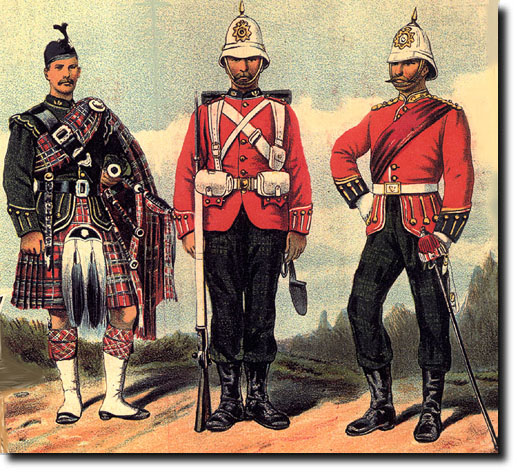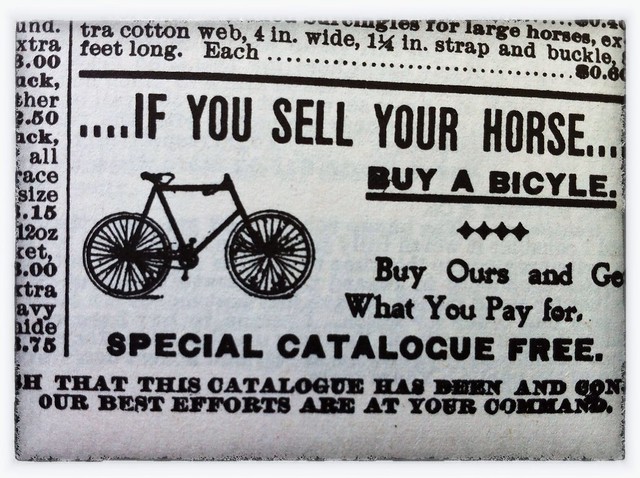It is often remarked that men's fashions haven't changed
much over the years. Compared to women's fashions they didn't, but
each decade did have it's own specialities, such as breeches or
lace and embroidery on waistcoats. In looking at cycling fashions for men, I want to start with a little background at the everyday fashions for men of the 1890's.
The military
greatly influence men's (and women) clothing, both in style and
colour (red jackets from the late 1700's and khaki in the tropics).
During the 1890's there were still of course wars going on, but the
fashion also looked towards the cycling craze of the time, and the overall
silhouette of the 1890's was long, lean, and athletic.
 |
| British army piper, private and office c 1890 source |
When we think of Victorian fashions for men, apart from military uniforms, we often think of the formal and evening wear - tails and top hats. Dinner jackets or tuxedo's were worn in the evening, and tails only for formal evening events, and of course special race days, with a top hat. White shirts were worn with both, with black or bow ties, although they were again popular as day time accessories during the 90's. The Ascot tie was also worn, usually as a day accessory, made up as a neckband with wide wings attached and worn with a stick-pin, and a bowler hat and other soft felt hats or caps were worn during the day.
  |
The Hon. Derek William George Keppel Elegantly dressed Vanity Fair Illustration
1895
and
Mr Victor Cavendish, MP for Derbyshire West, wearing top
hat. Vanity Fair Illustration 1895
|
Although frock coats and the cutaway morning
coat was still worn for formal day occasions in Europe and major
cities elsewhere, lounge (sack) jackets became popular for
day time wear. These were worn as a suit, either matching
three piece affairs with a single breasted jacket, waistcoat and
trousers, or with a contrasting waistcoat (vest). Fabric varied, and could be smooth and fine or rougher almost tweed.
 |
| Morning coat and lounge suits c. 1895. source |
 |
| Perhaps not a realistic cycling outfit of the time? |
 |
| White Flannel Pants, blazer & Boater - pants rolled up a little at least! |
The blazer was worn for casual activities such as sailing or
boating - cut in a similar style to the lounge coat, the fabric was
either navy blue or brightly-colored or striped, often in wool flannel, with
patch pockets and brass buttons. These were often worn with light coloured flannel
pants, or even shorts, with a straw boater or a cap.
 |
| Cycling in a blazer and cap c.1892 source |
  |
Mr
Rudolf Chambers Lehmann, rowing coach, In flannels and blazer and
Mr Charles Pittman, rower, in white shorts and sweater.
|
Tweed jackets (Norfolk jacket) were fashionable to
rugged outdoor and winter activities like hunting and shooting.
It featured paired box pleats over the chest and back for greater
arm movement, with a fabric belt. The matching trousers were
often replaced with matching breeches (knickerbockers) to make it suitable for suitable
for bicycling, and also golf, with knee-length stockings and low shoes, or for
hunting with sturdy boots or shoes with leather gaiters.
 |
| Sears Roebuck Catalogue 1897. source |
 |
| Tourists riding bicycles by A.B. Frost c.1896. |
 |
| Thomas E. Kent for Bicycle Clothing 1896 |
Tweed and breeches or plus fours seem to be the most remembered clothing for gentlemen cyclists of this time, as shown by the recent 'tweed ride' or tweed run' phenomena of the last few years. Find out more about this recreation of past cycling tours
here.
 |
| The poster from the first tweed run 2009 |
 |
| Caps & Breeches, cycling in Norway 1898 source |
Many ordinary gents, or those riding to work where breeches would have not been worn, wore their day suits for cycling. Some would tuck in one leg of there pants into their socks, to avoid it getting caught by the chain, and others would wear bicycle clips. I can remember my father doing this.
 |
| Man and cycle, long trousers and felt cap, c.1895 source |
 |
| Sear Roebuck Catalogue 1897 |
This gentleman looks like he did just sell his horse, don't you think!
 |
| man and cycle, long trousers, vest and Stetson c 1890s source |
Although studio posed, this gent looks ready to go, with his pants tucked partially into his socks, and his tie tucked into his shirt.
There was also specialist sporting clothing for athletes
such as swimmers, boxers and speed cyclists, but these were not generally worn by the ordinary man.
 |
| French Olympic cyclists 1896 source |
Where the military had influenced fashion, now the bicycle influenced the military. Cycling squads were formed, and uniforms altered slightly to accommodate cycling soldiers. A look at those next time.
Deb xx
























Perfect companion piece to yesterdays post!
ReplyDeletethank you, I am working my through the era in what I hope is an orderly fashion. these take so much research though, so I throw in a little post now and then of something faintly relevant!
ReplyDelete